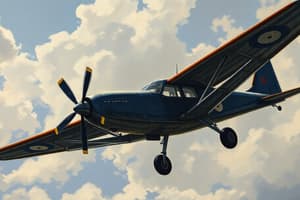Podcast
Questions and Answers
An airport is located within Class D airspace. What visibility and cloud clearance requirements must be met to operate an aircraft at this airport?
An airport is located within Class D airspace. What visibility and cloud clearance requirements must be met to operate an aircraft at this airport?
3 miles visibility, 1,000 feet above, 500 feet below, and 2,000 feet horizontal from clouds.
If a pilot wants to fly through a Military Operations Area (MOA), what actions should they take?
If a pilot wants to fly through a Military Operations Area (MOA), what actions should they take?
Contact Flight Service Station (FSS) to obtain the MOA's hours of operation and it is advised to contact controlling agency for traffic advisories.
What are the requirements for operating an aircraft in Class A airspace?
What are the requirements for operating an aircraft in Class A airspace?
Pilots require an instrument rating, must file an IFR flight plan, have a Mode C transponder, and maintain two-way radio communication with ATC.
Describe the equipment and communication requirements for operating within Class C airspace.
Describe the equipment and communication requirements for operating within Class C airspace.
What are the VFR weather minimums in Class G airspace below 1,200 feet AGL during the day?
What are the VFR weather minimums in Class G airspace below 1,200 feet AGL during the day?
A pilot is planning a VFR flight that will take them above 10,000 feet MSL. What visibility requirements apply?
A pilot is planning a VFR flight that will take them above 10,000 feet MSL. What visibility requirements apply?
What is the primary difference between a Restricted area and a Prohibited area?
What is the primary difference between a Restricted area and a Prohibited area?
What type of activity might be conducted in an Alert area?
What type of activity might be conducted in an Alert area?
Describe the Mode C veil and its requirements.
Describe the Mode C veil and its requirements.
What is the purpose of a Controlled Firing Area, and how does it ensure safety?
What is the purpose of a Controlled Firing Area, and how does it ensure safety?
Explain the difference in VFR weather minimums between Class E airspace below 10,000 feet MSL and above 10,000 feet MSL.
Explain the difference in VFR weather minimums between Class E airspace below 10,000 feet MSL and above 10,000 feet MSL.
What are the specific requirements for a student pilot to operate in Class B airspace?
What are the specific requirements for a student pilot to operate in Class B airspace?
Describe the conditions that would require a pilot to file an IFR flight plan.
Describe the conditions that would require a pilot to file an IFR flight plan.
What is the significance of the numbers associated with the cloud clearance requirements (e.g., 1,000 feet above, 500 feet below, 2,000 feet horizontal)?
What is the significance of the numbers associated with the cloud clearance requirements (e.g., 1,000 feet above, 500 feet below, 2,000 feet horizontal)?
If the visibility at an airport in Class D airspace is reported as 2.5 miles, can a pilot legally take off under VFR?
If the visibility at an airport in Class D airspace is reported as 2.5 miles, can a pilot legally take off under VFR?
Explain the potential hazards associated with operating in a Warning Area.
Explain the potential hazards associated with operating in a Warning Area.
What are the equipment requirements to operate in Class E airspace above 10,000 feet MSL?
What are the equipment requirements to operate in Class E airspace above 10,000 feet MSL?
A pilot is approaching an airport located within Class D airspace. When should the pilot establish two-way radio communication with ATC?
A pilot is approaching an airport located within Class D airspace. When should the pilot establish two-way radio communication with ATC?
Describe a situation where Class E airspace might begin at the surface.
Describe a situation where Class E airspace might begin at the surface.
What are the VFR weather minimums in Class G airspace at night?
What are the VFR weather minimums in Class G airspace at night?
Flashcards
Class A Airspace
Class A Airspace
Class A airspace extends from FL 180 to FL 600, requiring an instrument rating and IFR flight plan. A Mode C transponder and two-way radio communication are mandatory, with no specific weather minimums.
Class B Airspace
Class B Airspace
Class B airspace resembles an upside-down wedding cake, extending up to 10,000 feet MSL. Student pilots need an endorsement to enter, and ATC clearance is required. A Mode C transponder is mandatory within 30 nm, with visibility of 3 miles and clear of clouds.
Class C Airspace
Class C Airspace
Class C airspace has a 5 nm radius inner core (surface to 4,500' AGL) and a 10 nm outer core (1,200' AGL to 4,000' AGL). A Mode C transponder and two-way radio communication are needed with 3 miles visibility, 1,000' above, 500' below, and 2,000' horizontal cloud clearance.
Class D Airspace
Class D Airspace
Signup and view all the flashcards
Class E Airspace
Class E Airspace
Signup and view all the flashcards
Class G Airspace
Class G Airspace
Signup and view all the flashcards
Warning Area
Warning Area
Signup and view all the flashcards
Controlled Firing Area
Controlled Firing Area
Signup and view all the flashcards
Restricted Area
Restricted Area
Signup and view all the flashcards
Alert Area
Alert Area
Signup and view all the flashcards
Military Operations Area
Military Operations Area
Signup and view all the flashcards
Prohibited Area
Prohibited Area
Signup and view all the flashcards
Study Notes
- Airspace classes dictate equipment and weather minimums.
Class A Airspace
- Extends from FL 180 to FL 600.
- Requires an instrument rating and IFR flight plan.
- Requires a Mode C transponder and two-way radio communication.
- Has no weather minimums.
Class B Airspace
- Depicted as an upside-down wedding cake shape, up to 10,000 feet MSL.
- Student pilots need an endorsement to operate here.
- Requires clearance from ATC to enter.
- Requires a Mode C transponder within 30 nm (Mode C veil).
- Requires 3 miles visibility and clear of clouds.
Class C Airspace
- Inner core: 5 nm radius, surface to 4,500 feet AGL.
- Outer core: 10 nm radius, 1,200 feet AGL to 4,000 feet AGL.
- Requires a Mode C transponder and two-way radio communication.
- Requires 3 miles visibility, 1,000 feet above, 500 feet below, and 2,000 feet horizontal from clouds.
Class D Airspace
- 4 nm radius, surface to 2,500 feet AGL.
- Requires two-way radio communications.
- Requires 3 miles visibility, 1,000 feet above, 500 feet below, and 2,000 feet horizontal from clouds.
Class E Airspace
- Can begin at the surface, 700 feet AGL, or 1,200 feet AGL, extending up to (but not including) FL 180.
- Exists above FL 600.
- Has no equipment requirements.
- Below 10,000 feet MSL requires 3 miles visibility, 1,000 feet above, 500 feet below, and 2,000 feet horizontal from clouds.
- Above 10,000 feet MSL requires 5 miles visibility, 1,000 feet above, 1,000 feet below, and 1 mile horizontal from clouds.
Class G Airspace
- Uncontrolled airspace.
- Can start at the surface and extend up to 14,500 feet MSL or 1,200 feet AGL.
- Has no equipment requirements.
- Below 1,200 feet AGL requires 1 mile visibility and clear of clouds.
- Above 1,200 feet AGL, but below 10,000 feet MSL requires 1 mile visibility, 1,000 feet above, 500 feet below, and 2,000 feet horizontal from clouds. At night, 3 miles visibility, 1,000 feet above, 500 feet below, and 2,000 feet horizontal from clouds.
- Above 10,000 feet MSL requires 5 miles visibility, 1,000 feet above, 1,000 feet below, and 1 mile horizontal from clouds.
Special Use Airspace Types (WCRAMP)
- Warning Areas: Extend 3 nm outward from the U.S. coast and contain hazards to nonparticipating aircraft.
- Controlled Firing Areas: Hazardous activities are immediately suspended when an aircraft is spotted; these areas do not appear on charts.
- Restricted Areas: Contain unusual, often invisible hazards like artillery or missile firing; pilots need permission from the controlling authority to enter when active.
- Alert Areas: May contain a high volume of pilot training or unusual aerial activity; no clearance is needed, but pilots should be very alert.
- Military Operation Areas (MOA): Military training occurs here, such as aerial intercepts and low-altitude tactics; contact FSS for hours of operation and the controlling agency for traffic advisories; pilots should exercise extreme caution.
- Prohibited Areas: Designated for national security or welfare; flight in these areas is prohibited.
Studying That Suits You
Use AI to generate personalized quizzes and flashcards to suit your learning preferences.




